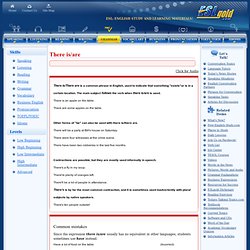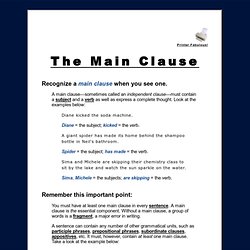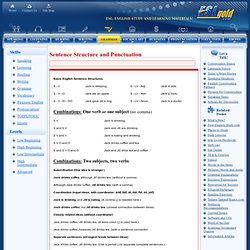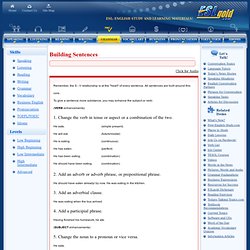

There is/are. Click for Audio There is/There are is a common phrase in English, used to indicate that something "exists"or is in a certain location.

The main subject follows the verb when there is/are is used. There is an apple on the table. There are some apples on the table. Other forms of "be" can also be used with there is/there are. There will be a party at Bill's house on Saturday. There were four witnesses at the crime scene. There have been two robberies in the last five months. Contractions are possible, but they are mostly used informally in speech. There's a fly in my soup. There're plenty of oranges left. There'll be a lot of people in attendance. There's is by far the most common contraction, and it is sometimes used inadvertently with plural subjects by native speakers.
There's ten people outside! Since the expression there is/are usually has no equivalent in other languages, students sometimes use have instead. See also : Grammar : Subject-Verb Agreement. The Linking Verb. Linking verbs do not express action.

Instead, they connect the subject of the verb to additional information about the subject. Look at the examples below: Keila is a shopaholic. Ising isn't something that Keila can do. Is connects the subject, Keila, to additional information about her, that she will soon have a huge credit card bill to pay. The following verbs are true linking verbs: any form of the verb be [am, is, are, was, were, has been, are being, might have been, etc.], become, and seem. Sylvia tasted the spicy squid eyeball stew. This substitution will not work for appear. Swooping out of the clear blue sky, the blue jay appeared on the branch. The Main Clause. Printer Fabulous!

Recognize a main clause when you see one. A main clause—sometimes called an independent clause—must contain a subject and a verb as well as express a complete thought. Look at the examples below: Diane kicked the soda machine. Diane = the subject; kicked = the verb. Remember this important point: You must have at least one main clause in every sentence. While dissecting a cow heart in her anatomy and physiology class, Shenicka realized that a cheeseburger, her favorite lunch, was no longer appetizing. Do not confuse a main clause with a subordinate clause. When you place a subordinate conjunction in front of a subject and verb, you will no longer have a complete thought.
When Diane kicked the soda machine ... Home • Terms • Exercises • Handouts • Rules • Shop • Feedback ©1997 - 2014 by Robin L. Valid html. Subordinators. Sentence Structure and Punctuation. Basic English Sentence Structures Combinations: One verb or one subject (no comma) Combinations: Two subjects, two verbs Subordination (One idea is stronger.)

Jack drinks coffee although Jill drinks tea. (without a comma) Although Jack drinks coffee, Jill drinks tea. Coordination (equal ideas, with coordinator: and, but, or, nor, for, so, yet) Jack is drinking, and Jill is eating. Jack drinks coffee, but Jill drinks tea. Closely related ideas (without coordinator) Jack drinks coffee; Jill drinks tea. Jack drinks coffee; however, Jill drinks tea. Separate sentences (strongest break between ideas) Indirect Objects. Subject-Verb Agreement. Click for Audio Third person singular -s Use the -s form of a verb in the present tense when the subject is third person singular.

For all other subjects, use the base form in the present tense. Example: base form. Building Sentences. Remember, the S - V relationship is at the "heart" of every sentence.

All sentences are built around this core. To give a sentence more substance, you may enhance the subject or verb: (VERB enhancements) Noun and Verb Phrases. Noun Phrases Noun Phrases are groups of words that can function as subjects or objects in sentences.

They may take on various forms: Pronouns and similar words can also function as subjects and objects: He gave the money to us. Basic Sentence Structure and patterns for practicing English as a second language (ESL) There are five basic patterns around which most English sentences are built.* They are as follows: At the heart of every English sentence is the Subject-Verb relationship.

Other elements can be added to make a sentence more interesting, but they are not essential to its formation. The following sentences are examples of the S-V pattern. Note: Any action verb can be used with this sentence pattern. The following sentences are examples of the S-V-O pattern. Note: Only transitive action verbs can be used with this sentence pattern.